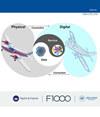A discrete event simulation-based methodology for building a digital twin of patient pathways in the hospital for near real-time monitoring and predictive simulation
引用次数: 2
Abstract
Background: Discrete Event Simulation (DES) is one of the many tools and methods used in the analysis and improvement of healthcare services. Indeed, DES provides perhaps the most powerful and intuitive method for analyzing, evaluating, and improving complex healthcare systems. This paper highlights the process of developing a Digital Twin (DT) framework based on online DES to run the DES model in parallel with the real world in real-time. Methods: This paper suggests a new methodology that uses DES connected to the Internet of Things (IoT) devices to build a DT platform of patient pathways in a hospital for near real-time monitoring and predictive simulation. An experimental platform that mimics the behavior of a hospital has been used to validate this methodology. Results: The application of the proposed methodology allowed us to test the monitoring functionality in the DT. Therefore, we noticed that the DT behaves exactly as the emulator does in near real-time, we also tested the prediction functionality and we noticed that the DT provides us with a proactive overview for the near future of the patient pathways. The predictive functionality of this DT must be improved depending on the various reasons mentioned in this article. Conclusions: This paper presents a new methodology called HospiT'Win that uses DES and IoT devices to develop a DT of patient pathways in hospitals. This DT consists of two real-time models, a DT for Monitoring (DTM) and a DT for Predicting (DTP). An experimental platform with an emulator of a real hospital was used to validate this methodology before connecting to the real hospital. In the DTP, "dynamic" empirical distributions were used to perform a predictive simulation for the near future. In future research, some additional features and machine learning algorithms will be used to improve the proposed DT models.一种基于离散事件模拟的方法,用于在医院中构建患者路径的数字孪生,用于近实时监测和预测模拟
背景:离散事件模拟(DES)是用于分析和改进医疗服务的许多工具和方法之一。事实上,DES可能为分析、评估和改进复杂的医疗保健系统提供了最强大、最直观的方法。本文重点介绍了开发一个基于在线DES的数字孪生(DT)框架的过程,以使DES模型与现实世界实时并行运行。方法:本文提出了一种新的方法,使用连接到物联网(IoT)设备的DES来构建医院患者路径的DT平台,用于近实时监测和预测模拟。一个模拟医院行为的实验平台已经被用来验证这种方法。结果:所提出的方法的应用使我们能够测试DT中的监控功能。因此,我们注意到DT的行为与模拟器在近实时情况下的行为完全相同,我们还测试了预测功能,并注意到DT为我们提供了对近期患者路径的前瞻性概述。根据本文中提到的各种原因,必须改进此DT的预测功能。结论:本文提出了一种名为HospiT'Win的新方法,该方法使用DES和物联网设备来开发医院患者路径的DT。该DT由两个实时模型组成,一个用于监测的DT(DTM)和一个用于预测的DT(DTP)。在连接到真实医院之前,使用带有真实医院模拟器的实验平台来验证该方法。在DTP中,“动态”经验分布用于对不久的将来进行预测模拟。在未来的研究中,一些额外的特征和机器学习算法将用于改进所提出的DT模型。
本文章由计算机程序翻译,如有差异,请以英文原文为准。
求助全文
约1分钟内获得全文
求助全文
来源期刊

Digital Twin
digital twin technologies-
自引率
0.00%
发文量
0
期刊介绍:
Digital Twin is a rapid multidisciplinary open access publishing platform for state-of-the-art, basic, scientific and applied research on digital twin technologies. Digital Twin covers all areas related digital twin technologies, including broad fields such as smart manufacturing, civil and industrial engineering, healthcare, agriculture, and many others. The platform is open to submissions from researchers, practitioners and experts, and all articles will benefit from open peer review.
The aim of Digital Twin is to advance the state-of-the-art in digital twin research and encourage innovation by highlighting efficient, robust and sustainable multidisciplinary applications across a variety of fields. Challenges can be addressed using theoretical, methodological, and technological approaches.
The scope of Digital Twin includes, but is not limited to, the following areas:
● Digital twin concepts, architecture, and frameworks
● Digital twin theory and method
● Digital twin key technologies and tools
● Digital twin applications and case studies
● Digital twin implementation
● Digital twin services
● Digital twin security
● Digital twin standards
Digital twin also focuses on applications within and across broad sectors including:
● Smart manufacturing
● Aviation and aerospace
● Smart cities and construction
● Healthcare and medicine
● Robotics
● Shipping, vehicles and railways
● Industrial engineering and engineering management
● Agriculture
● Mining
● Power, energy and environment
Digital Twin features a range of article types including research articles, case studies, method articles, study protocols, software tools, systematic reviews, data notes, brief reports, and opinion articles.
 求助内容:
求助内容: 应助结果提醒方式:
应助结果提醒方式:


